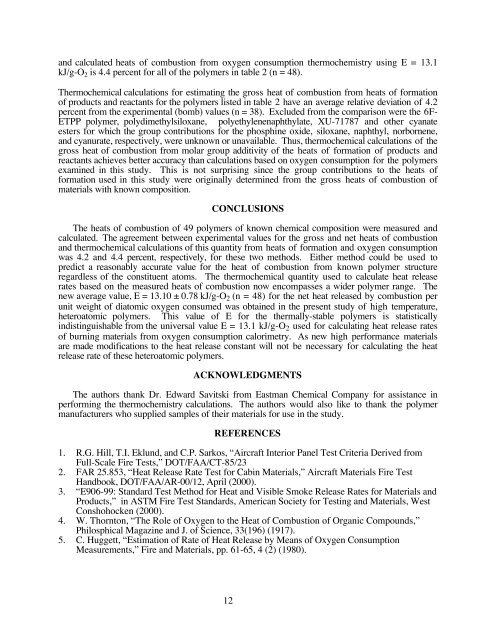HEATS OF COMBUSTION OF HIGH TEMPERATURE POLYMERS
HEATS OF COMBUSTION OF HIGH TEMPERATURE POLYMERS
HEATS OF COMBUSTION OF HIGH TEMPERATURE POLYMERS
You also want an ePaper? Increase the reach of your titles
YUMPU automatically turns print PDFs into web optimized ePapers that Google loves.
and calculated heats of combustion from oxygen consumption thermochemistry using E = 13.1<br />
kJ/g-O 2 is 4.4 percent for all of the polymers in table 2 (n = 48).<br />
Thermochemical calculations for estimating the gross heat of combustion from heats of formation<br />
of products and reactants for the polymers listed in table 2 have an average relative deviation of 4.2<br />
percent from the experimental (bomb) values (n = 38). Excluded from the comparison were the 6F-<br />
ETPP polymer, polydimethylsiloxane, polyethylenenaphthylate, XU-71787 and other cyanate<br />
esters for which the group contributions for the phosphine oxide, siloxane, naphthyl, norbornene,<br />
and cyanurate, respectively, were unknown or unavailable. Thus, thermochemical calculations of the<br />
gross heat of combustion from molar group additivity of the heats of formation of products and<br />
reactants achieves better accuracy than calculations based on oxygen consumption for the polymers<br />
examined in this study. This is not surprising since the group contributions to the heats of<br />
formation used in this study were originally determined from the gross heats of combustion of<br />
materials with known composition.<br />
CONCLUSIONS<br />
The heats of combustion of 49 polymers of known chemical composition were measured and<br />
calculated. The agreement between experimental values for the gross and net heats of combustion<br />
and thermochemical calculations of this quantity from heats of formation and oxygen consumption<br />
was 4.2 and 4.4 percent, respectively, for these two methods. Either method could be used to<br />
predict a reasonably accurate value for the heat of combustion from known polymer structure<br />
regardless of the constituent atoms. The thermochemical quantity used to calculate heat release<br />
rates based on the measured heats of combustion now encompasses a wider polymer range. The<br />
new average value, E = 13.10 ± 0.78 kJ/g-O2 (n = 48) for the net heat released by combustion per<br />
unit weight of diatomic oxygen consumed was obtained in the present study of high temperature,<br />
heteroatomic polymers. This value of E for the thermally-stable polymers is statistically<br />
indistinguishable from the universal value E = 13.1 kJ/g-O2 used for calculating heat release rates<br />
of burning materials from oxygen consumption calorimetry. As new high performance materials<br />
are made modifications to the heat release constant will not be necessary for calculating the heat<br />
release rate of these heteroatomic polymers.<br />
ACKNOWLEDGMENTS<br />
The authors thank Dr. Edward Savitski from Eastman Chemical Company for assistance in<br />
performing the thermochemistry calculations. The authors would also like to thank the polymer<br />
manufacturers who supplied samples of their materials for use in the study.<br />
REFERENCES<br />
1. R.G. Hill, T.I. Eklund, and C.P. Sarkos, “Aircraft Interior Panel Test Criteria Derived from<br />
Full-Scale Fire Tests,” DOT/FAA/CT-85/23<br />
2. FAR 25.853, “Heat Release Rate Test for Cabin Materials,” Aircraft Materials Fire Test<br />
Handbook, DOT/FAA/AR-00/12, April (2000).<br />
3. “E906-99: Standard Test Method for Heat and Visible Smoke Release Rates for Materials and<br />
Products,” in ASTM Fire Test Standards, American Society for Testing and Materials, West<br />
Conshohocken (2000).<br />
4. W. Thornton, “The Role of Oxygen to the Heat of Combustion of Organic Compounds,”<br />
Philosphical Magazine and J. of Science, 33(196) (1917).<br />
5. C. Huggett, “Estimation of Rate of Heat Release by Means of Oxygen Consumption<br />
Measurements,” Fire and Materials, pp. 61-65, 4 (2) (1980).<br />
12
















